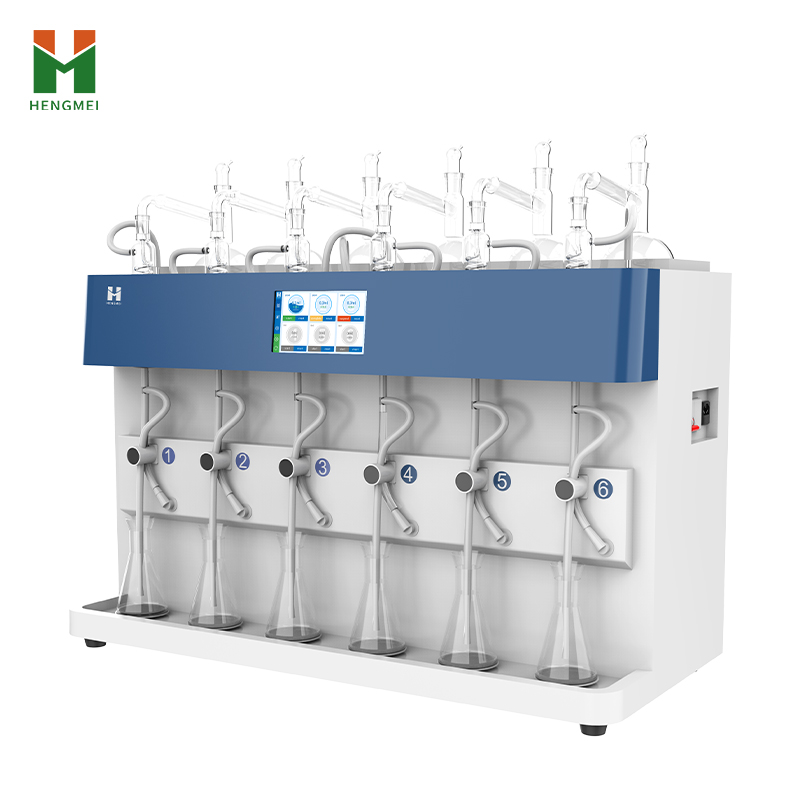In many fields such as chemical analysis, food testing, pharmaceutical research and development, and environmental monitoring, the separation and purification of substances is an indispensable key link. As the core equipment for implementing this process, the multifunctional distillation apparatus has become an important support for ensuring the accuracy of experimental results and product quality in scientific research and industrial production due to its efficient and precise separation ability. It not only inherits the essence of traditional distillation technology, but also achieves breakthroughs in automation, intelligence, safety, and other aspects through the empowerment of modern technology, providing strong technical support for separation and purification work in various industries. It plays an important role in improving production efficiency, reducing costs, and ensuring product quality.

Technical advantage
The multifunctional distillation apparatus can be widely used in many fields, closely related to its significant technological advantages. These advantages not only improve the efficiency and quality of separation and purification, but also bring users a convenient operating experience.
Firstly, in terms of processing capacity and control accuracy, the batch processing capacity of the instrument is 1-6, which can meet the experimental needs of different scales. More importantly, each channel is independently controlled, which means that users can simultaneously distill different samples, and the distillation parameters of each sample do not affect each other, greatly improving the flexibility and efficiency of the experiment. At the same time, each channel is equipped with functional protection designs to prevent backflow, excessive distillation, and dry burning, ensuring the safe conduct of experiments from multiple aspects and avoiding experimental failures and equipment damage caused by improper operation or unexpected situations.
Secondly, in terms of operational convenience and intelligence, the multifunctional distillation apparatus adopts a 7-inch LCD touch screen control, with an intuitive and clear interface, and operators can easily complete the setting of various parameters. The distillation method can be set and automatically saved, and can be directly called up the next time it is turned on, saving the trouble of repeated settings and making it particularly suitable for standardized experimental procedures. The system comes with a calibration function for distillation volume (weight), ensuring the accuracy of distillation results and reducing the impact of human error on experimental results.
Again, in terms of heating performance, the heating module of the multifunctional distillation apparatus adopts a standard bowl shaped fiberglass electric heating jacket heater. This design ensures that the sample container (round bottom flask) is closely attached to the heat source, allowing heat to be evenly and efficiently transferred to the sample. At the same time, the heating power adjustment range is wide, and the heating intensity can be flexibly adjusted according to the characteristics of different samples, ensuring the uniformity of heating and thermal radiation efficiency. This not only accelerates the distillation speed but also extends the service life of the equipment.
In addition, in terms of controllability and automation of the distillation process, the multifunctional distiller can set the distillation amount and time, and users can accurately control the distillation process according to experimental requirements. The equipment displays the real-time operating status, distillation volume, and remaining distillation time, allowing operators to keep track of the experimental progress at any time. Each distillation unit can be set with a single hole timing and quantity, independently controlled, and operated independently. After distillation, it can automatically stop heating and cut off the distillate pipeline, and automatically release pressure, achieving automatic unmanned operation, greatly reducing the workload of operators, and avoiding experimental errors caused by human negligence.
Application field
The multifunctional distiller, with its excellent separation and purification capabilities, has a wide and important range of applications in multiple fields, providing key technical support for the development of various industries.
In the field of food testing, multifunctional stills are commonly used for the extraction and detection of volatile components in food, such as the determination of alcohol content and the detection of residual sulfur dioxide in food. For example, when detecting the alcohol content in wine, instruments are used to distill the alcohol in the wine, and its content is determined through subsequent testing methods, providing a basis for evaluating the quality of the wine.
In the field of pharmaceutical research and development, multifunctional distillers are important equipment for drug purification and solvent recovery. In the process of drug synthesis, instruments can be used to separate intermediate products or target drugs with high purity, ensuring the quality and safety of the drugs. Meanwhile, the instrument can recycle and reuse the organic solvents used in the experiment, reducing experimental costs and minimizing environmental pollution.
In the field of environmental monitoring, multifunctional distillation apparatus can be used for the separation and determination of volatile phenols, cyanides and other pollutants in water quality monitoring. For example, when treating industrial wastewater, instruments are used to distill volatile phenols from the wastewater for subsequent quantitative analysis, providing data support for evaluating the degree of water pollution and developing treatment plans.
In the field of chemical analysis, a multifunctional distiller is a fundamental equipment for material separation and purification, widely used in experiments such as organic synthesis and compound identification. By using instruments, different components in the mixture can be separated, providing pure samples for in-depth research on the properties and structure of substances.
Solution
In order to better meet the needs of different users in different scenarios, the multifunctional distillation apparatus provides a series of targeted solutions, optimizing both equipment functions and operation processes.
In response to the demand for simultaneous processing of multiple samples, the instrument's 1-6 batch processing capacity and the design of independent control for each channel enable users to conduct multiple experiments simultaneously, greatly improving work efficiency. Whether it is small-scale experiments in scientific research laboratories or pilot projects in industrial production, suitable processing modes can be found.
In terms of operational convenience, the 7-inch LCD touch screen control and storable distillation method save users from tedious operating steps. For routine experiments, users only need to call saved methods to start the experiment, reducing the possibility of operational errors, especially suitable for novice operators to quickly get started.
In terms of safety assurance, the functional protection design against backflow, excessive distillation, and dry burning provides comprehensive safety protection for the experimental process. Even when the operator temporarily leaves or unexpected situations occur, it can effectively avoid danger and allow users to conduct experiments with more peace of mind.
In addition, the dual control mode of distillation endpoint time and weight ensures the consistency and accuracy of distillation results. Users can choose the appropriate endpoint control method according to the specific requirements of the experiment, whether it is an experiment with strict requirements for distillation volume or an experiment that needs to be completed within a specific time, reliable results can be obtained.
Article address:http://www.labinstruments.net/news/59.html







